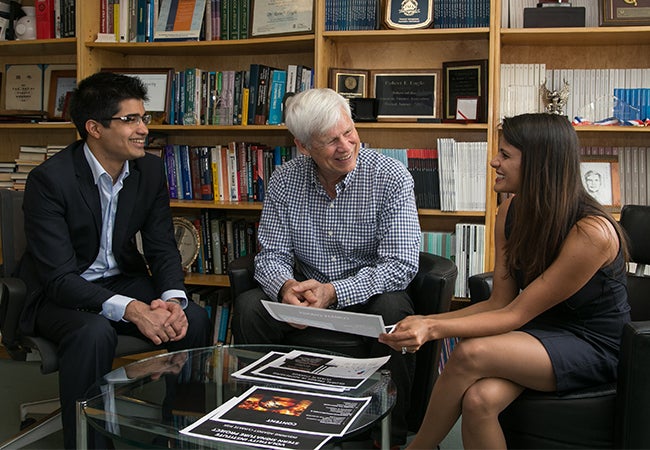Stern Stories
Invest Possible
—
Through a new Stern Signature Project with Nobel Laureate Robert Engle, three MBA students developed an investment portfolio to help investors hedge against climate change risk.

From the World Bank to the United Nations to the Environmental Protection Agency, researchers and policymakers around the world are recognizing the growing impact of climate change on everything from natural resources to infrastructure. Greenhouse gas (GHG) emissions are one of the most common metrics to determine environmental impact, both on an individual and organizational level, garnering significant attention from scientific communities, politicians, environmental activists and the media. But what role do investors play in the climate change conversation, and can a “greener” portfolio be beneficial to both the Earth and earnings?
A team of MBA students – Ankita Gupta, Moideen Kalladi and Derek Meitzer – recently partnered with NYU Stern’s Volatility Institute to find out. Under the guidance of Professor and Nobel Laureate Robert Engle and PhD student Heebum Lee, the students developed a simulated equity portfolio with a long position for companies with strong GHG ratings and a short position for GHG underperformers. By studying abnormal returns, or returns in excess of predictions, the students evaluated the impact of climate change risk in equity markets, particularly following shock events, to determine whether investors are influencing larger environmental trends.
“For us, it was important to know if, how and when investors act on environmental concerns,” Derek explained. “Investors are also consumers, voters and workers, and they play a valuable part in the human response to our changing environment.”
Hailing from different professional backgrounds ranging from healthcare administration to software engineering to algorithmic trading, the students approached the project with a robust set of skills and perspectives.
“In some ways, this is uncharted territory, which really helped us stretch our entrepreneurial spirits, analytical skills and project management experience,” Ankita reflected. “We were learning to apply concepts on our own and to manage both ourselves and our team through deliverables that were not pre-defined.”
“Making judgment calls about when and how to limit the scope of a project, performing complex analyses on ever-changing data and presenting our results to a broad audience were all invaluable complements to more traditional classroom learning,” Moideen concurred.
From a back test they find that 60% of the time, their GHG portfolio has a higher Sharpe ratio than the S&P500.
Their study reveals key trends with potential benefits for companies, their shareholders and stakeholders alike. “There’s a growing movement toward environmental protection policies and carbon pricing policies internationally, but companies are not currently charging a premium aligning with their GHG metrics,” Ankita explained. “This is an early period for investors to buy at lower rates and reap the reward later.”
Moideen continued, “Based on these findings, there is a correlation between a higher GHG rating and growth in shareholder value, providing another reason why lowering emissions should become an important part of every company’s strategy.”
“Climate risk has been a growing international concern for many years now,” Professor Engle said. “Through this project, our students are helping to build the business case – for both companies and their investors – for a more sustainable world.”
